Report on Developing Individual, Team, and Organization Performance
VerifiedAdded on 2023/03/24
|12
|3594
|80
Report
AI Summary
This report delves into the crucial aspects of human resource management, focusing on developing individuals, teams, and organizations. It begins by identifying the essential knowledge, skills, and behaviors (KSB) required by HR professionals, emphasizing the importance of promoting equality, collaboration, and strategic thinking. The report then evaluates a personal skills audit to pinpoint training and development needs, followed by the creation of a professional development plan for an HR officer role. A key section contrasts organizational and individual learning, highlighting the differences between training and development. The report further discusses the necessity of continuous learning and professional development to enhance sustainable business performance, exploring how high-performance work (HPW) contributes to employee engagement and competitive advantage. Different approaches to performance management are also examined. The report concludes by emphasizing the importance of HR efficiency and effective decision-making in achieving organizational goals.
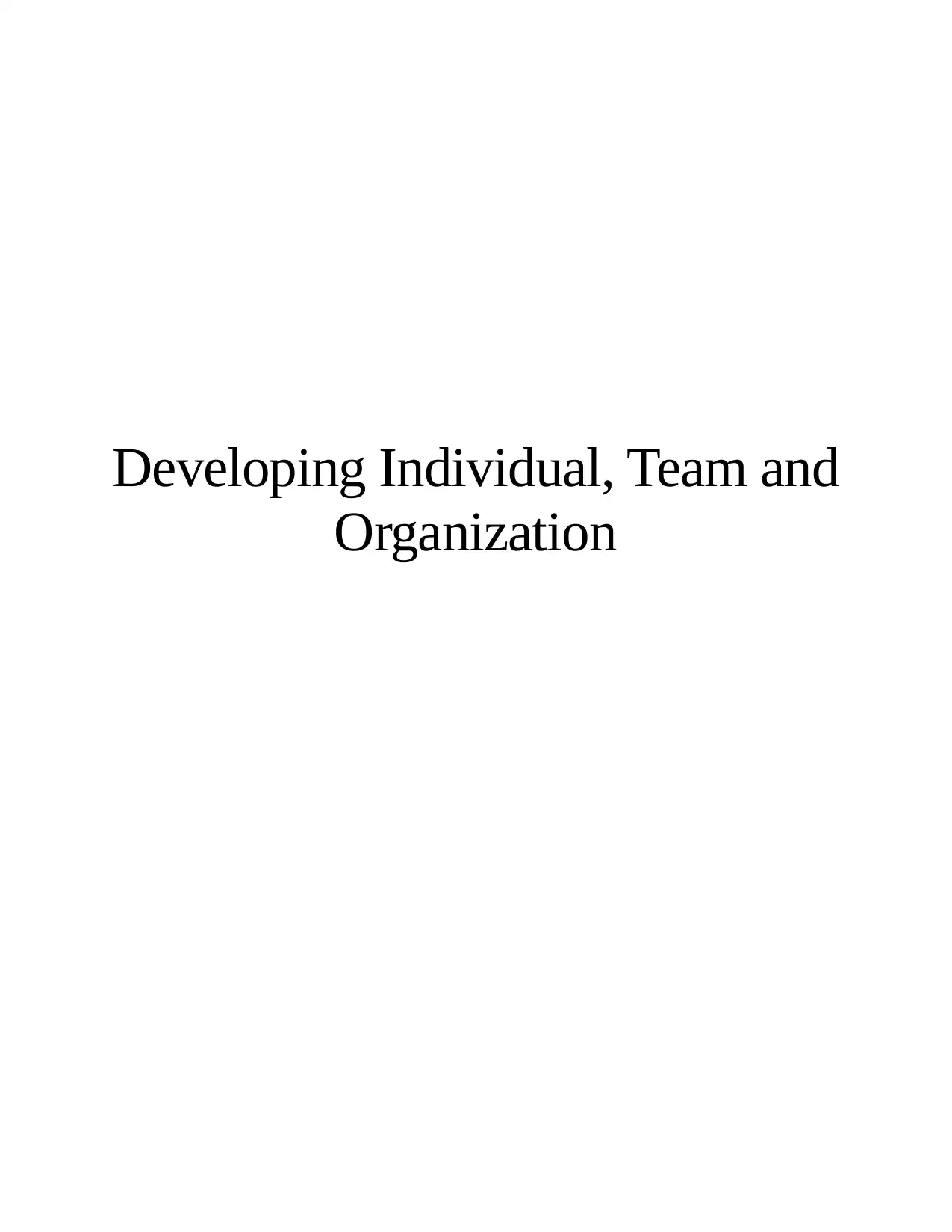
Developing Individual, Team and
Organization
Organization
Paraphrase This Document
Need a fresh take? Get an instant paraphrase of this document with our AI Paraphraser
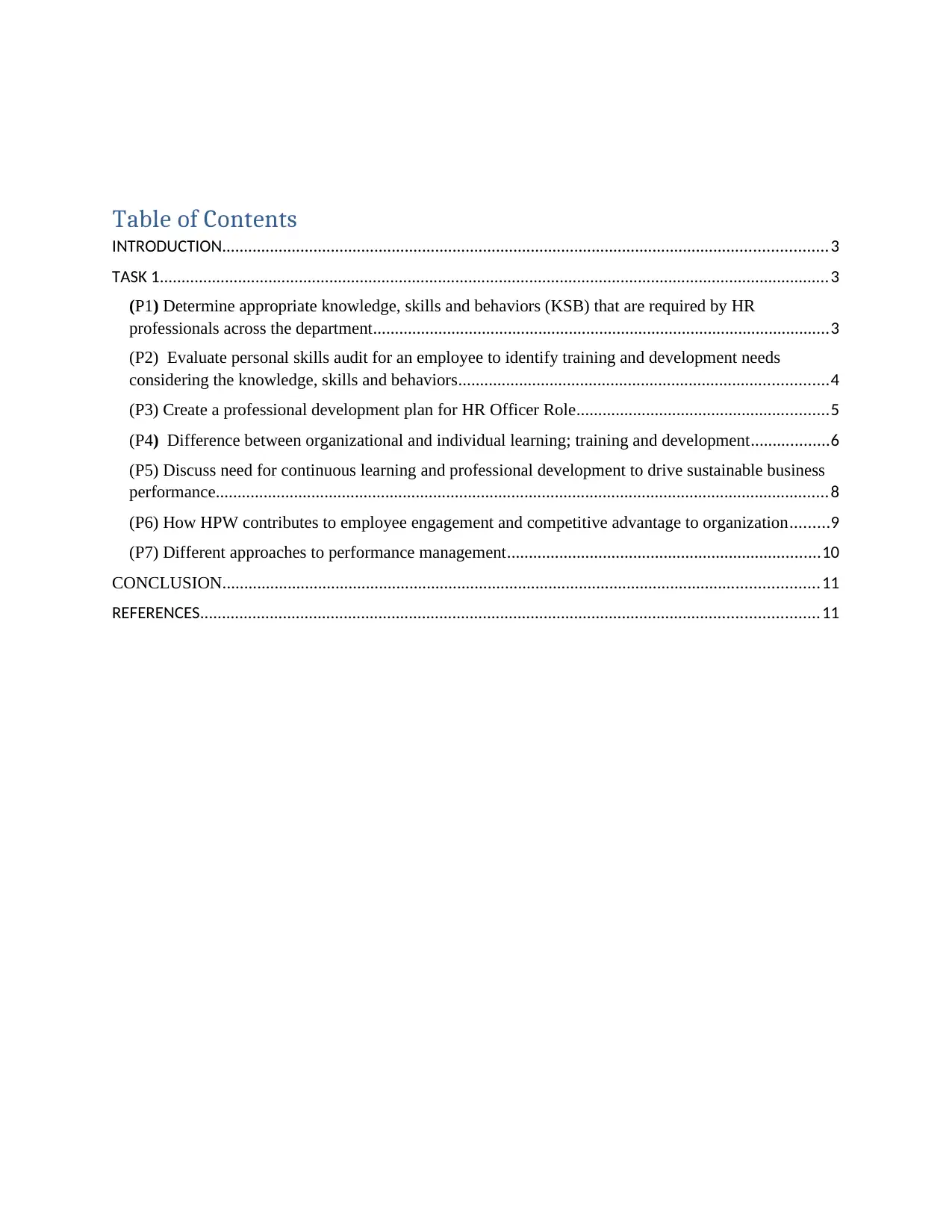
Table of Contents
INTRODUCTION...........................................................................................................................................3
TASK 1..........................................................................................................................................................3
(P1) Determine appropriate knowledge, skills and behaviors (KSB) that are required by HR
professionals across the department.........................................................................................................3
(P2) Evaluate personal skills audit for an employee to identify training and development needs
considering the knowledge, skills and behaviors.....................................................................................4
(P3) Create a professional development plan for HR Officer Role..........................................................5
(P4) Difference between organizational and individual learning; training and development..................6
(P5) Discuss need for continuous learning and professional development to drive sustainable business
performance.............................................................................................................................................8
(P6) How HPW contributes to employee engagement and competitive advantage to organization.........9
(P7) Different approaches to performance management........................................................................10
CONCLUSION.........................................................................................................................................11
REFERENCES..............................................................................................................................................11
INTRODUCTION...........................................................................................................................................3
TASK 1..........................................................................................................................................................3
(P1) Determine appropriate knowledge, skills and behaviors (KSB) that are required by HR
professionals across the department.........................................................................................................3
(P2) Evaluate personal skills audit for an employee to identify training and development needs
considering the knowledge, skills and behaviors.....................................................................................4
(P3) Create a professional development plan for HR Officer Role..........................................................5
(P4) Difference between organizational and individual learning; training and development..................6
(P5) Discuss need for continuous learning and professional development to drive sustainable business
performance.............................................................................................................................................8
(P6) How HPW contributes to employee engagement and competitive advantage to organization.........9
(P7) Different approaches to performance management........................................................................10
CONCLUSION.........................................................................................................................................11
REFERENCES..............................................................................................................................................11
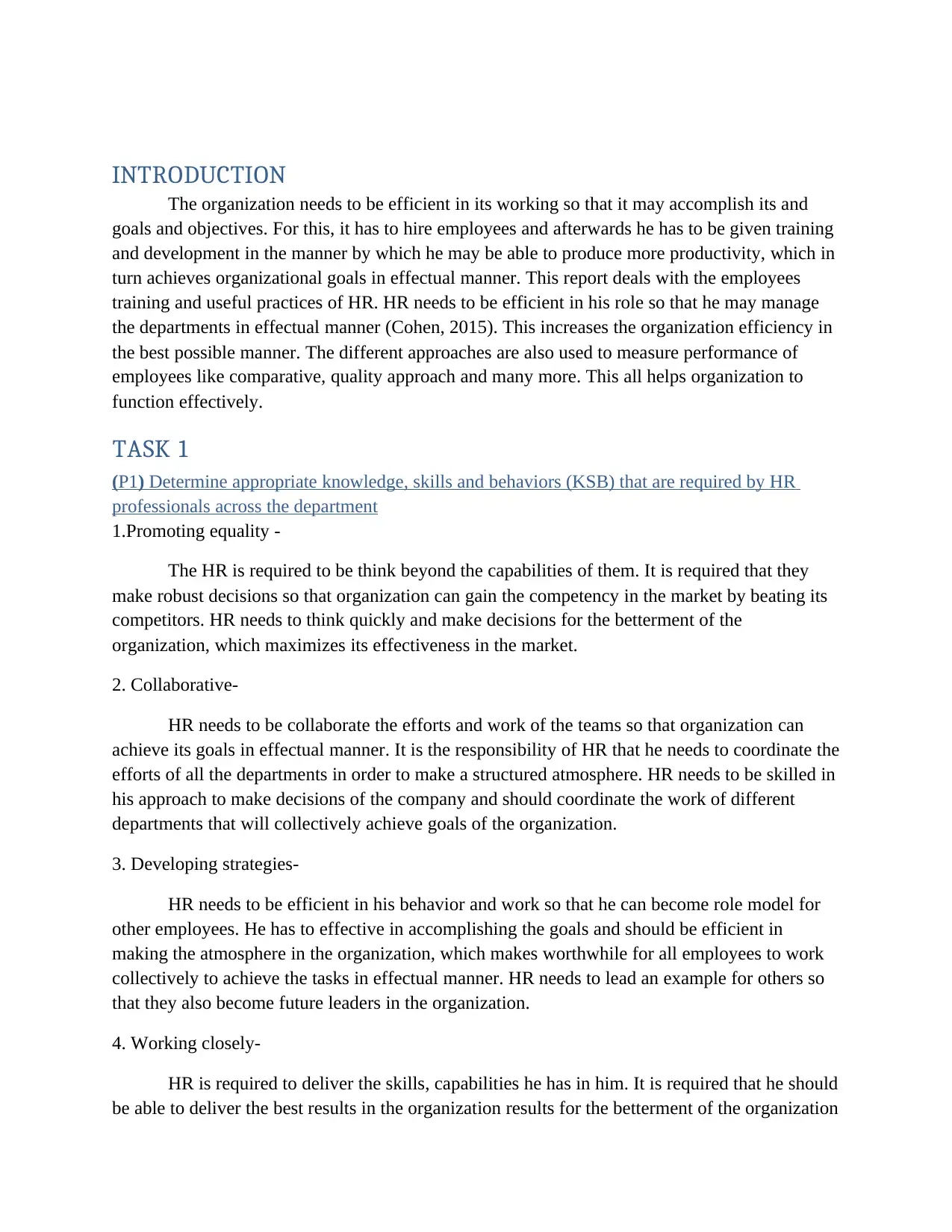
INTRODUCTION
The organization needs to be efficient in its working so that it may accomplish its and
goals and objectives. For this, it has to hire employees and afterwards he has to be given training
and development in the manner by which he may be able to produce more productivity, which in
turn achieves organizational goals in effectual manner. This report deals with the employees
training and useful practices of HR. HR needs to be efficient in his role so that he may manage
the departments in effectual manner (Cohen, 2015). This increases the organization efficiency in
the best possible manner. The different approaches are also used to measure performance of
employees like comparative, quality approach and many more. This all helps organization to
function effectively.
TASK 1
(P1) Determine appropriate knowledge, skills and behaviors (KSB) that are required by HR
professionals across the department
1.Promoting equality -
The HR is required to be think beyond the capabilities of them. It is required that they
make robust decisions so that organization can gain the competency in the market by beating its
competitors. HR needs to think quickly and make decisions for the betterment of the
organization, which maximizes its effectiveness in the market.
2. Collaborative-
HR needs to be collaborate the efforts and work of the teams so that organization can
achieve its goals in effectual manner. It is the responsibility of HR that he needs to coordinate the
efforts of all the departments in order to make a structured atmosphere. HR needs to be skilled in
his approach to make decisions of the company and should coordinate the work of different
departments that will collectively achieve goals of the organization.
3. Developing strategies-
HR needs to be efficient in his behavior and work so that he can become role model for
other employees. He has to effective in accomplishing the goals and should be efficient in
making the atmosphere in the organization, which makes worthwhile for all employees to work
collectively to achieve the tasks in effectual manner. HR needs to lead an example for others so
that they also become future leaders in the organization.
4. Working closely-
HR is required to deliver the skills, capabilities he has in him. It is required that he should
be able to deliver the best results in the organization results for the betterment of the organization
The organization needs to be efficient in its working so that it may accomplish its and
goals and objectives. For this, it has to hire employees and afterwards he has to be given training
and development in the manner by which he may be able to produce more productivity, which in
turn achieves organizational goals in effectual manner. This report deals with the employees
training and useful practices of HR. HR needs to be efficient in his role so that he may manage
the departments in effectual manner (Cohen, 2015). This increases the organization efficiency in
the best possible manner. The different approaches are also used to measure performance of
employees like comparative, quality approach and many more. This all helps organization to
function effectively.
TASK 1
(P1) Determine appropriate knowledge, skills and behaviors (KSB) that are required by HR
professionals across the department
1.Promoting equality -
The HR is required to be think beyond the capabilities of them. It is required that they
make robust decisions so that organization can gain the competency in the market by beating its
competitors. HR needs to think quickly and make decisions for the betterment of the
organization, which maximizes its effectiveness in the market.
2. Collaborative-
HR needs to be collaborate the efforts and work of the teams so that organization can
achieve its goals in effectual manner. It is the responsibility of HR that he needs to coordinate the
efforts of all the departments in order to make a structured atmosphere. HR needs to be skilled in
his approach to make decisions of the company and should coordinate the work of different
departments that will collectively achieve goals of the organization.
3. Developing strategies-
HR needs to be efficient in his behavior and work so that he can become role model for
other employees. He has to effective in accomplishing the goals and should be efficient in
making the atmosphere in the organization, which makes worthwhile for all employees to work
collectively to achieve the tasks in effectual manner. HR needs to lead an example for others so
that they also become future leaders in the organization.
4. Working closely-
HR is required to deliver the skills, capabilities he has in him. It is required that he should
be able to deliver the best results in the organization results for the betterment of the organization
⊘ This is a preview!⊘
Do you want full access?
Subscribe today to unlock all pages.

Trusted by 1+ million students worldwide
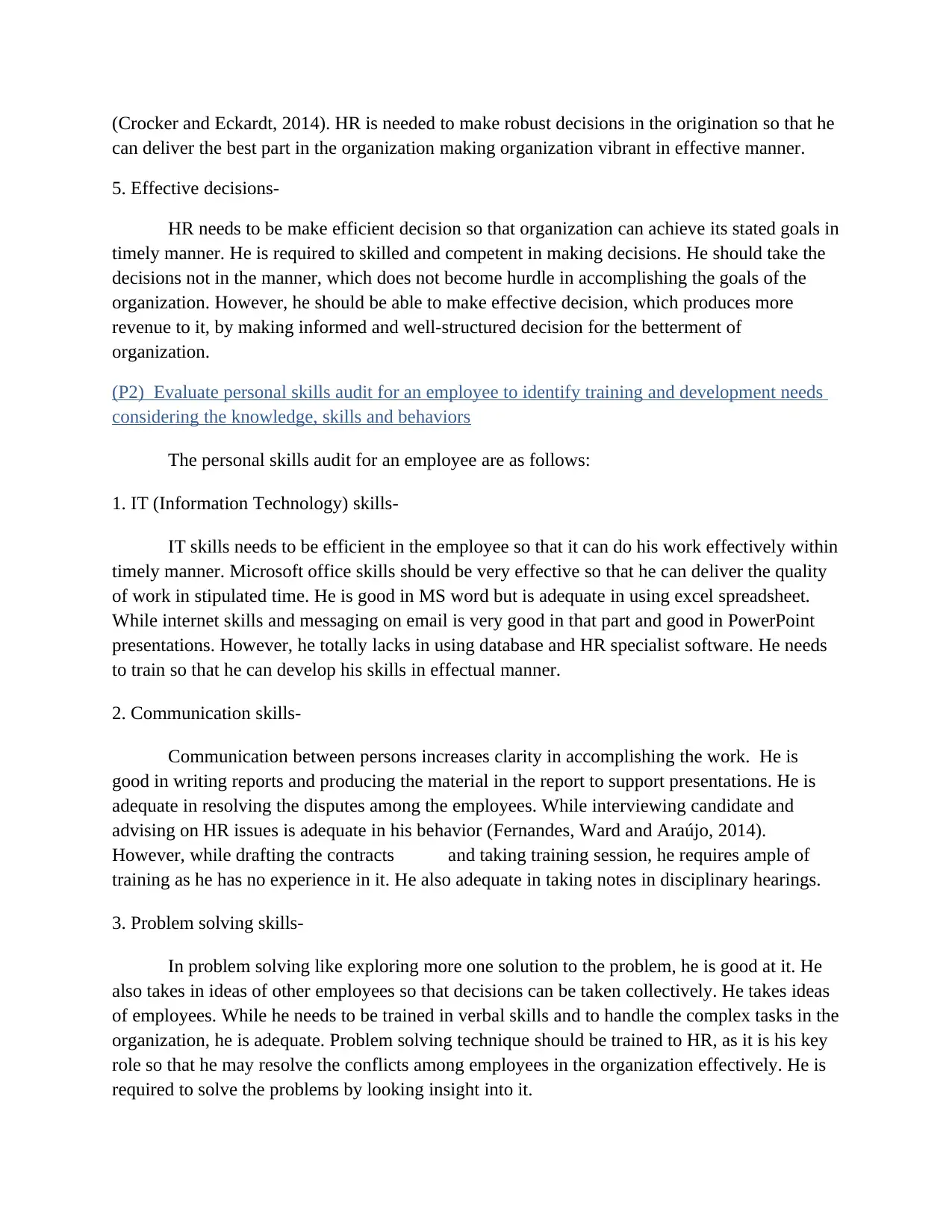
(Crocker and Eckardt, 2014). HR is needed to make robust decisions in the origination so that he
can deliver the best part in the organization making organization vibrant in effective manner.
5. Effective decisions-
HR needs to be make efficient decision so that organization can achieve its stated goals in
timely manner. He is required to skilled and competent in making decisions. He should take the
decisions not in the manner, which does not become hurdle in accomplishing the goals of the
organization. However, he should be able to make effective decision, which produces more
revenue to it, by making informed and well-structured decision for the betterment of
organization.
(P2) Evaluate personal skills audit for an employee to identify training and development needs
considering the knowledge, skills and behaviors
The personal skills audit for an employee are as follows:
1. IT (Information Technology) skills-
IT skills needs to be efficient in the employee so that it can do his work effectively within
timely manner. Microsoft office skills should be very effective so that he can deliver the quality
of work in stipulated time. He is good in MS word but is adequate in using excel spreadsheet.
While internet skills and messaging on email is very good in that part and good in PowerPoint
presentations. However, he totally lacks in using database and HR specialist software. He needs
to train so that he can develop his skills in effectual manner.
2. Communication skills-
Communication between persons increases clarity in accomplishing the work. He is
good in writing reports and producing the material in the report to support presentations. He is
adequate in resolving the disputes among the employees. While interviewing candidate and
advising on HR issues is adequate in his behavior (Fernandes, Ward and Araújo, 2014).
However, while drafting the contracts and taking training session, he requires ample of
training as he has no experience in it. He also adequate in taking notes in disciplinary hearings.
3. Problem solving skills-
In problem solving like exploring more one solution to the problem, he is good at it. He
also takes in ideas of other employees so that decisions can be taken collectively. He takes ideas
of employees. While he needs to be trained in verbal skills and to handle the complex tasks in the
organization, he is adequate. Problem solving technique should be trained to HR, as it is his key
role so that he may resolve the conflicts among employees in the organization effectively. He is
required to solve the problems by looking insight into it.
can deliver the best part in the organization making organization vibrant in effective manner.
5. Effective decisions-
HR needs to be make efficient decision so that organization can achieve its stated goals in
timely manner. He is required to skilled and competent in making decisions. He should take the
decisions not in the manner, which does not become hurdle in accomplishing the goals of the
organization. However, he should be able to make effective decision, which produces more
revenue to it, by making informed and well-structured decision for the betterment of
organization.
(P2) Evaluate personal skills audit for an employee to identify training and development needs
considering the knowledge, skills and behaviors
The personal skills audit for an employee are as follows:
1. IT (Information Technology) skills-
IT skills needs to be efficient in the employee so that it can do his work effectively within
timely manner. Microsoft office skills should be very effective so that he can deliver the quality
of work in stipulated time. He is good in MS word but is adequate in using excel spreadsheet.
While internet skills and messaging on email is very good in that part and good in PowerPoint
presentations. However, he totally lacks in using database and HR specialist software. He needs
to train so that he can develop his skills in effectual manner.
2. Communication skills-
Communication between persons increases clarity in accomplishing the work. He is
good in writing reports and producing the material in the report to support presentations. He is
adequate in resolving the disputes among the employees. While interviewing candidate and
advising on HR issues is adequate in his behavior (Fernandes, Ward and Araújo, 2014).
However, while drafting the contracts and taking training session, he requires ample of
training as he has no experience in it. He also adequate in taking notes in disciplinary hearings.
3. Problem solving skills-
In problem solving like exploring more one solution to the problem, he is good at it. He
also takes in ideas of other employees so that decisions can be taken collectively. He takes ideas
of employees. While he needs to be trained in verbal skills and to handle the complex tasks in the
organization, he is adequate. Problem solving technique should be trained to HR, as it is his key
role so that he may resolve the conflicts among employees in the organization effectively. He is
required to solve the problems by looking insight into it.
Paraphrase This Document
Need a fresh take? Get an instant paraphrase of this document with our AI Paraphraser
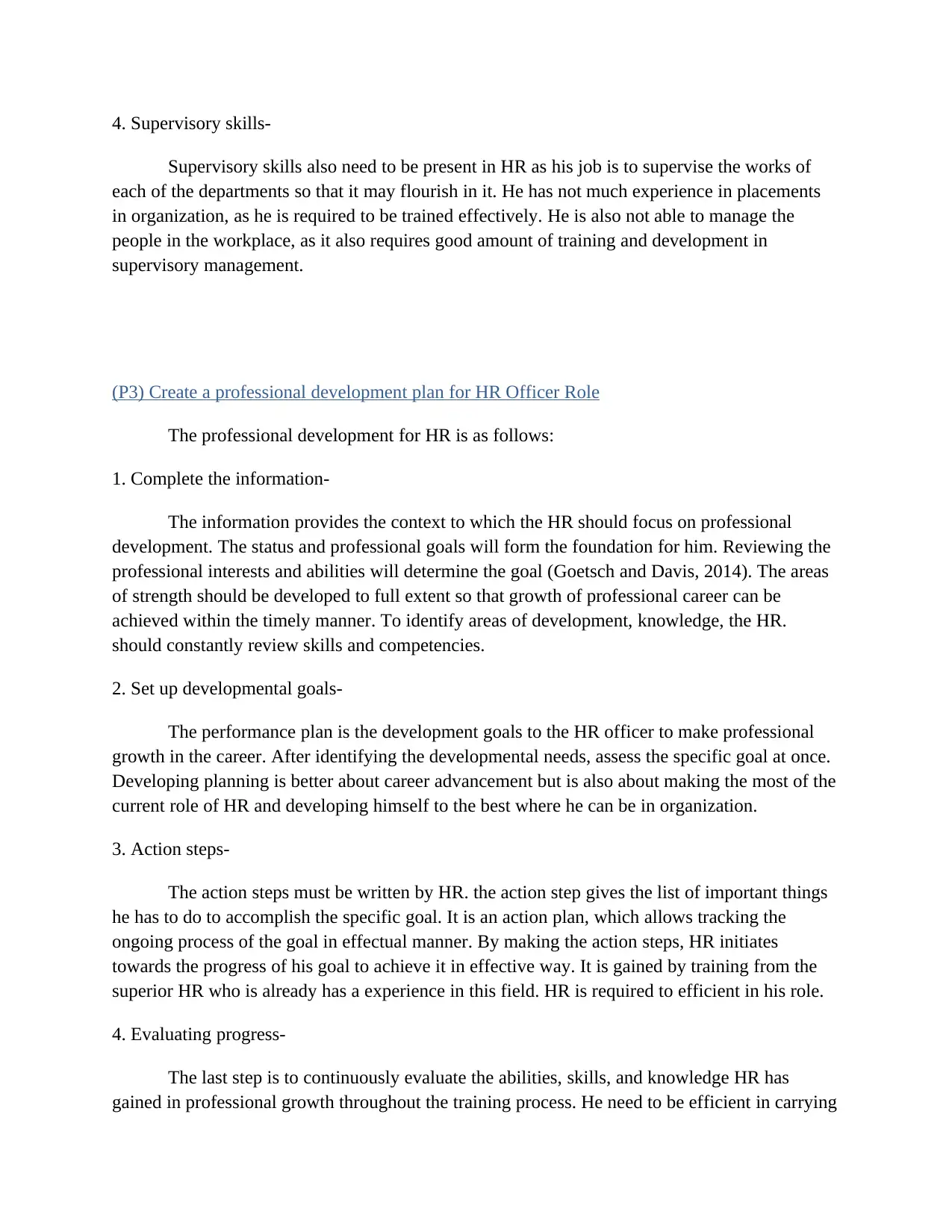
4. Supervisory skills-
Supervisory skills also need to be present in HR as his job is to supervise the works of
each of the departments so that it may flourish in it. He has not much experience in placements
in organization, as he is required to be trained effectively. He is also not able to manage the
people in the workplace, as it also requires good amount of training and development in
supervisory management.
(P3) Create a professional development plan for HR Officer Role
The professional development for HR is as follows:
1. Complete the information-
The information provides the context to which the HR should focus on professional
development. The status and professional goals will form the foundation for him. Reviewing the
professional interests and abilities will determine the goal (Goetsch and Davis, 2014). The areas
of strength should be developed to full extent so that growth of professional career can be
achieved within the timely manner. To identify areas of development, knowledge, the HR.
should constantly review skills and competencies.
2. Set up developmental goals-
The performance plan is the development goals to the HR officer to make professional
growth in the career. After identifying the developmental needs, assess the specific goal at once.
Developing planning is better about career advancement but is also about making the most of the
current role of HR and developing himself to the best where he can be in organization.
3. Action steps-
The action steps must be written by HR. the action step gives the list of important things
he has to do to accomplish the specific goal. It is an action plan, which allows tracking the
ongoing process of the goal in effectual manner. By making the action steps, HR initiates
towards the progress of his goal to achieve it in effective way. It is gained by training from the
superior HR who is already has a experience in this field. HR is required to efficient in his role.
4. Evaluating progress-
The last step is to continuously evaluate the abilities, skills, and knowledge HR has
gained in professional growth throughout the training process. He need to be efficient in carrying
Supervisory skills also need to be present in HR as his job is to supervise the works of
each of the departments so that it may flourish in it. He has not much experience in placements
in organization, as he is required to be trained effectively. He is also not able to manage the
people in the workplace, as it also requires good amount of training and development in
supervisory management.
(P3) Create a professional development plan for HR Officer Role
The professional development for HR is as follows:
1. Complete the information-
The information provides the context to which the HR should focus on professional
development. The status and professional goals will form the foundation for him. Reviewing the
professional interests and abilities will determine the goal (Goetsch and Davis, 2014). The areas
of strength should be developed to full extent so that growth of professional career can be
achieved within the timely manner. To identify areas of development, knowledge, the HR.
should constantly review skills and competencies.
2. Set up developmental goals-
The performance plan is the development goals to the HR officer to make professional
growth in the career. After identifying the developmental needs, assess the specific goal at once.
Developing planning is better about career advancement but is also about making the most of the
current role of HR and developing himself to the best where he can be in organization.
3. Action steps-
The action steps must be written by HR. the action step gives the list of important things
he has to do to accomplish the specific goal. It is an action plan, which allows tracking the
ongoing process of the goal in effectual manner. By making the action steps, HR initiates
towards the progress of his goal to achieve it in effective way. It is gained by training from the
superior HR who is already has a experience in this field. HR is required to efficient in his role.
4. Evaluating progress-
The last step is to continuously evaluate the abilities, skills, and knowledge HR has
gained in professional growth throughout the training process. He need to be efficient in carrying
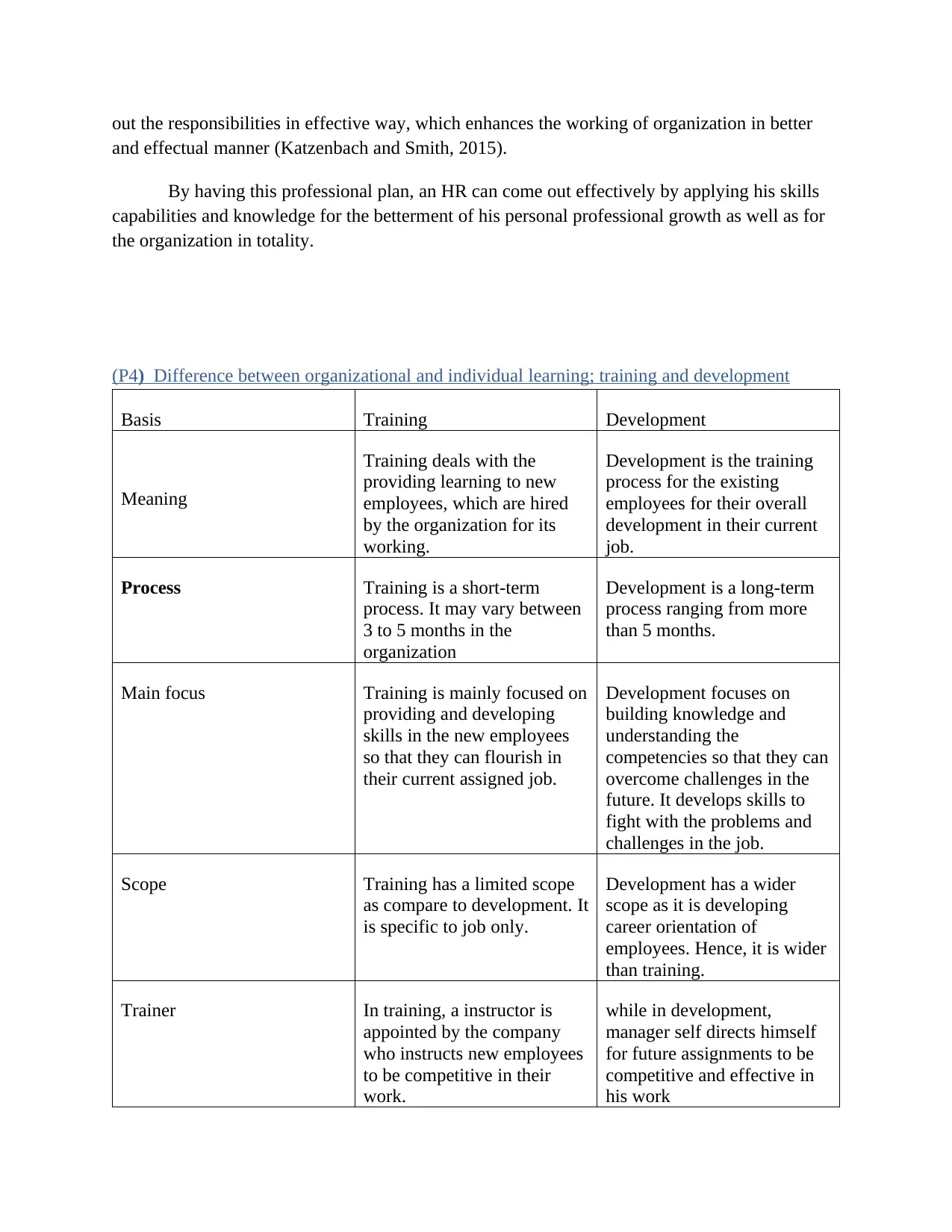
out the responsibilities in effective way, which enhances the working of organization in better
and effectual manner (Katzenbach and Smith, 2015).
By having this professional plan, an HR can come out effectively by applying his skills
capabilities and knowledge for the betterment of his personal professional growth as well as for
the organization in totality.
(P4) Difference between organizational and individual learning; training and development
Basis Training Development
Meaning
Training deals with the
providing learning to new
employees, which are hired
by the organization for its
working.
Development is the training
process for the existing
employees for their overall
development in their current
job.
Process Training is a short-term
process. It may vary between
3 to 5 months in the
organization
Development is a long-term
process ranging from more
than 5 months.
Main focus Training is mainly focused on
providing and developing
skills in the new employees
so that they can flourish in
their current assigned job.
Development focuses on
building knowledge and
understanding the
competencies so that they can
overcome challenges in the
future. It develops skills to
fight with the problems and
challenges in the job.
Scope Training has a limited scope
as compare to development. It
is specific to job only.
Development has a wider
scope as it is developing
career orientation of
employees. Hence, it is wider
than training.
Trainer In training, a instructor is
appointed by the company
who instructs new employees
to be competitive in their
work.
while in development,
manager self directs himself
for future assignments to be
competitive and effective in
his work
and effectual manner (Katzenbach and Smith, 2015).
By having this professional plan, an HR can come out effectively by applying his skills
capabilities and knowledge for the betterment of his personal professional growth as well as for
the organization in totality.
(P4) Difference between organizational and individual learning; training and development
Basis Training Development
Meaning
Training deals with the
providing learning to new
employees, which are hired
by the organization for its
working.
Development is the training
process for the existing
employees for their overall
development in their current
job.
Process Training is a short-term
process. It may vary between
3 to 5 months in the
organization
Development is a long-term
process ranging from more
than 5 months.
Main focus Training is mainly focused on
providing and developing
skills in the new employees
so that they can flourish in
their current assigned job.
Development focuses on
building knowledge and
understanding the
competencies so that they can
overcome challenges in the
future. It develops skills to
fight with the problems and
challenges in the job.
Scope Training has a limited scope
as compare to development. It
is specific to job only.
Development has a wider
scope as it is developing
career orientation of
employees. Hence, it is wider
than training.
Trainer In training, a instructor is
appointed by the company
who instructs new employees
to be competitive in their
work.
while in development,
manager self directs himself
for future assignments to be
competitive and effective in
his work
⊘ This is a preview!⊘
Do you want full access?
Subscribe today to unlock all pages.

Trusted by 1+ million students worldwide
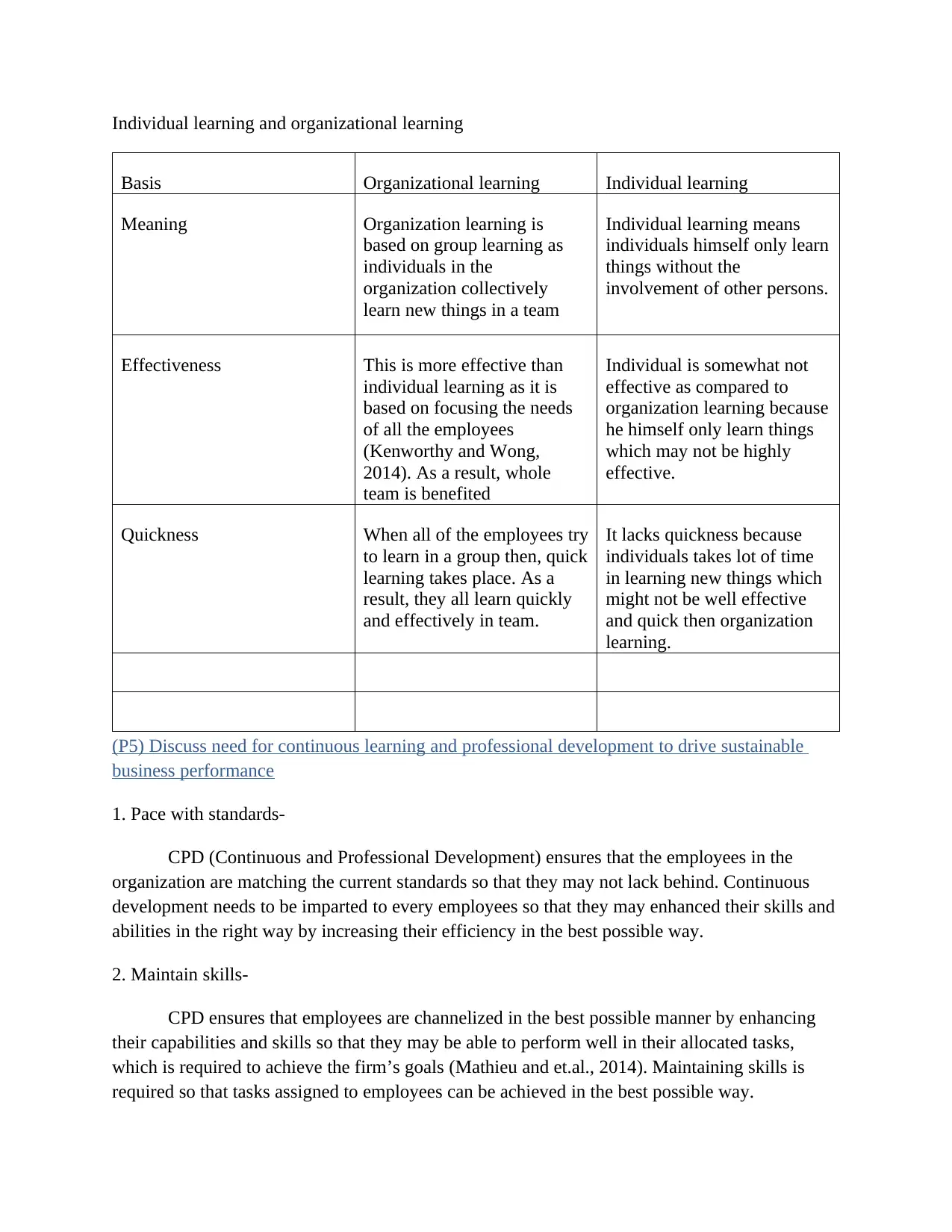
Individual learning and organizational learning
Basis Organizational learning Individual learning
Meaning Organization learning is
based on group learning as
individuals in the
organization collectively
learn new things in a team
Individual learning means
individuals himself only learn
things without the
involvement of other persons.
Effectiveness This is more effective than
individual learning as it is
based on focusing the needs
of all the employees
(Kenworthy and Wong,
2014). As a result, whole
team is benefited
Individual is somewhat not
effective as compared to
organization learning because
he himself only learn things
which may not be highly
effective.
Quickness When all of the employees try
to learn in a group then, quick
learning takes place. As a
result, they all learn quickly
and effectively in team.
It lacks quickness because
individuals takes lot of time
in learning new things which
might not be well effective
and quick then organization
learning.
(P5) Discuss need for continuous learning and professional development to drive sustainable
business performance
1. Pace with standards-
CPD (Continuous and Professional Development) ensures that the employees in the
organization are matching the current standards so that they may not lack behind. Continuous
development needs to be imparted to every employees so that they may enhanced their skills and
abilities in the right way by increasing their efficiency in the best possible way.
2. Maintain skills-
CPD ensures that employees are channelized in the best possible manner by enhancing
their capabilities and skills so that they may be able to perform well in their allocated tasks,
which is required to achieve the firm’s goals (Mathieu and et.al., 2014). Maintaining skills is
required so that tasks assigned to employees can be achieved in the best possible way.
Basis Organizational learning Individual learning
Meaning Organization learning is
based on group learning as
individuals in the
organization collectively
learn new things in a team
Individual learning means
individuals himself only learn
things without the
involvement of other persons.
Effectiveness This is more effective than
individual learning as it is
based on focusing the needs
of all the employees
(Kenworthy and Wong,
2014). As a result, whole
team is benefited
Individual is somewhat not
effective as compared to
organization learning because
he himself only learn things
which may not be highly
effective.
Quickness When all of the employees try
to learn in a group then, quick
learning takes place. As a
result, they all learn quickly
and effectively in team.
It lacks quickness because
individuals takes lot of time
in learning new things which
might not be well effective
and quick then organization
learning.
(P5) Discuss need for continuous learning and professional development to drive sustainable
business performance
1. Pace with standards-
CPD (Continuous and Professional Development) ensures that the employees in the
organization are matching the current standards so that they may not lack behind. Continuous
development needs to be imparted to every employees so that they may enhanced their skills and
abilities in the right way by increasing their efficiency in the best possible way.
2. Maintain skills-
CPD ensures that employees are channelized in the best possible manner by enhancing
their capabilities and skills so that they may be able to perform well in their allocated tasks,
which is required to achieve the firm’s goals (Mathieu and et.al., 2014). Maintaining skills is
required so that tasks assigned to employees can be achieved in the best possible way.
Paraphrase This Document
Need a fresh take? Get an instant paraphrase of this document with our AI Paraphraser
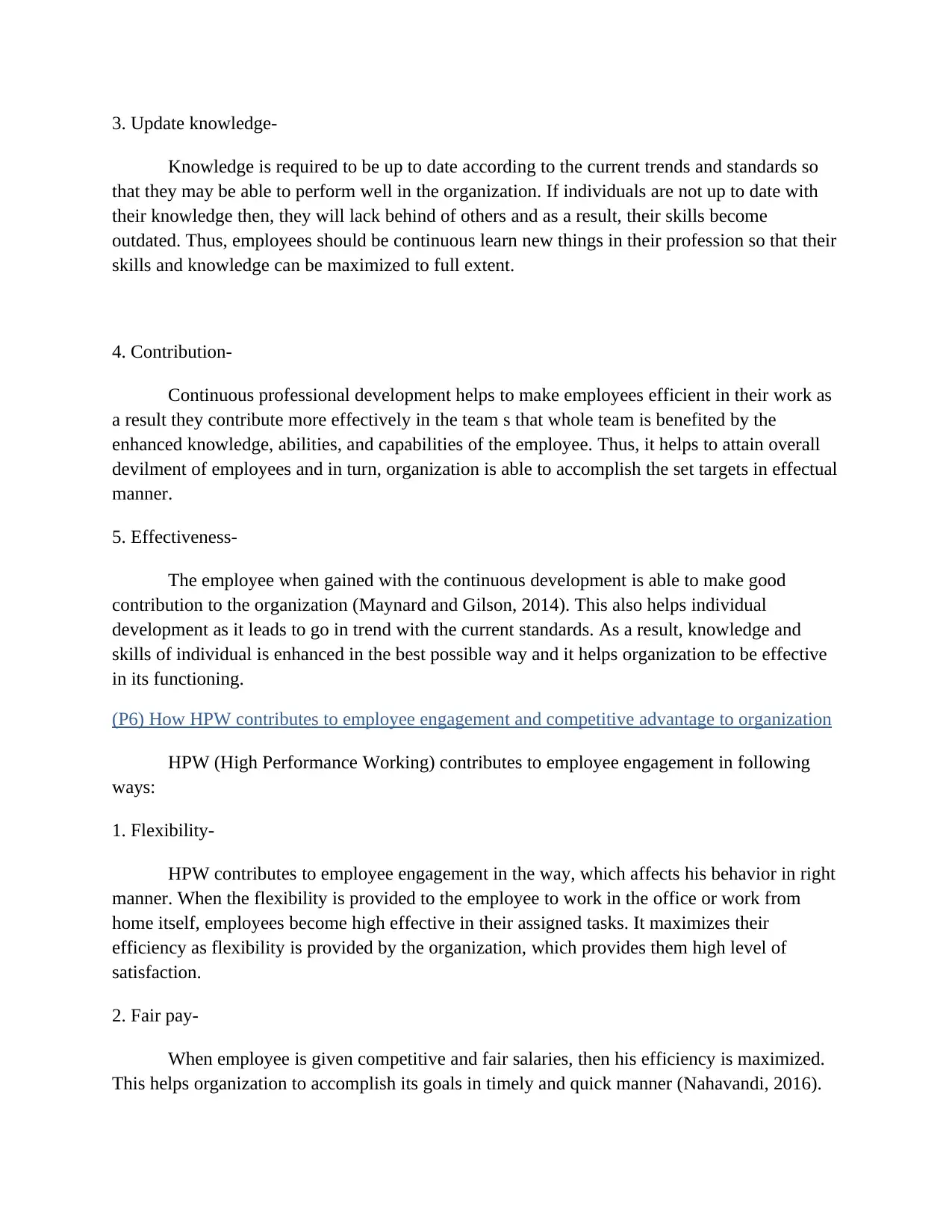
3. Update knowledge-
Knowledge is required to be up to date according to the current trends and standards so
that they may be able to perform well in the organization. If individuals are not up to date with
their knowledge then, they will lack behind of others and as a result, their skills become
outdated. Thus, employees should be continuous learn new things in their profession so that their
skills and knowledge can be maximized to full extent.
4. Contribution-
Continuous professional development helps to make employees efficient in their work as
a result they contribute more effectively in the team s that whole team is benefited by the
enhanced knowledge, abilities, and capabilities of the employee. Thus, it helps to attain overall
devilment of employees and in turn, organization is able to accomplish the set targets in effectual
manner.
5. Effectiveness-
The employee when gained with the continuous development is able to make good
contribution to the organization (Maynard and Gilson, 2014). This also helps individual
development as it leads to go in trend with the current standards. As a result, knowledge and
skills of individual is enhanced in the best possible way and it helps organization to be effective
in its functioning.
(P6) How HPW contributes to employee engagement and competitive advantage to organization
HPW (High Performance Working) contributes to employee engagement in following
ways:
1. Flexibility-
HPW contributes to employee engagement in the way, which affects his behavior in right
manner. When the flexibility is provided to the employee to work in the office or work from
home itself, employees become high effective in their assigned tasks. It maximizes their
efficiency as flexibility is provided by the organization, which provides them high level of
satisfaction.
2. Fair pay-
When employee is given competitive and fair salaries, then his efficiency is maximized.
This helps organization to accomplish its goals in timely and quick manner (Nahavandi, 2016).
Knowledge is required to be up to date according to the current trends and standards so
that they may be able to perform well in the organization. If individuals are not up to date with
their knowledge then, they will lack behind of others and as a result, their skills become
outdated. Thus, employees should be continuous learn new things in their profession so that their
skills and knowledge can be maximized to full extent.
4. Contribution-
Continuous professional development helps to make employees efficient in their work as
a result they contribute more effectively in the team s that whole team is benefited by the
enhanced knowledge, abilities, and capabilities of the employee. Thus, it helps to attain overall
devilment of employees and in turn, organization is able to accomplish the set targets in effectual
manner.
5. Effectiveness-
The employee when gained with the continuous development is able to make good
contribution to the organization (Maynard and Gilson, 2014). This also helps individual
development as it leads to go in trend with the current standards. As a result, knowledge and
skills of individual is enhanced in the best possible way and it helps organization to be effective
in its functioning.
(P6) How HPW contributes to employee engagement and competitive advantage to organization
HPW (High Performance Working) contributes to employee engagement in following
ways:
1. Flexibility-
HPW contributes to employee engagement in the way, which affects his behavior in right
manner. When the flexibility is provided to the employee to work in the office or work from
home itself, employees become high effective in their assigned tasks. It maximizes their
efficiency as flexibility is provided by the organization, which provides them high level of
satisfaction.
2. Fair pay-
When employee is given competitive and fair salaries, then his efficiency is maximized.
This helps organization to accomplish its goals in timely and quick manner (Nahavandi, 2016).
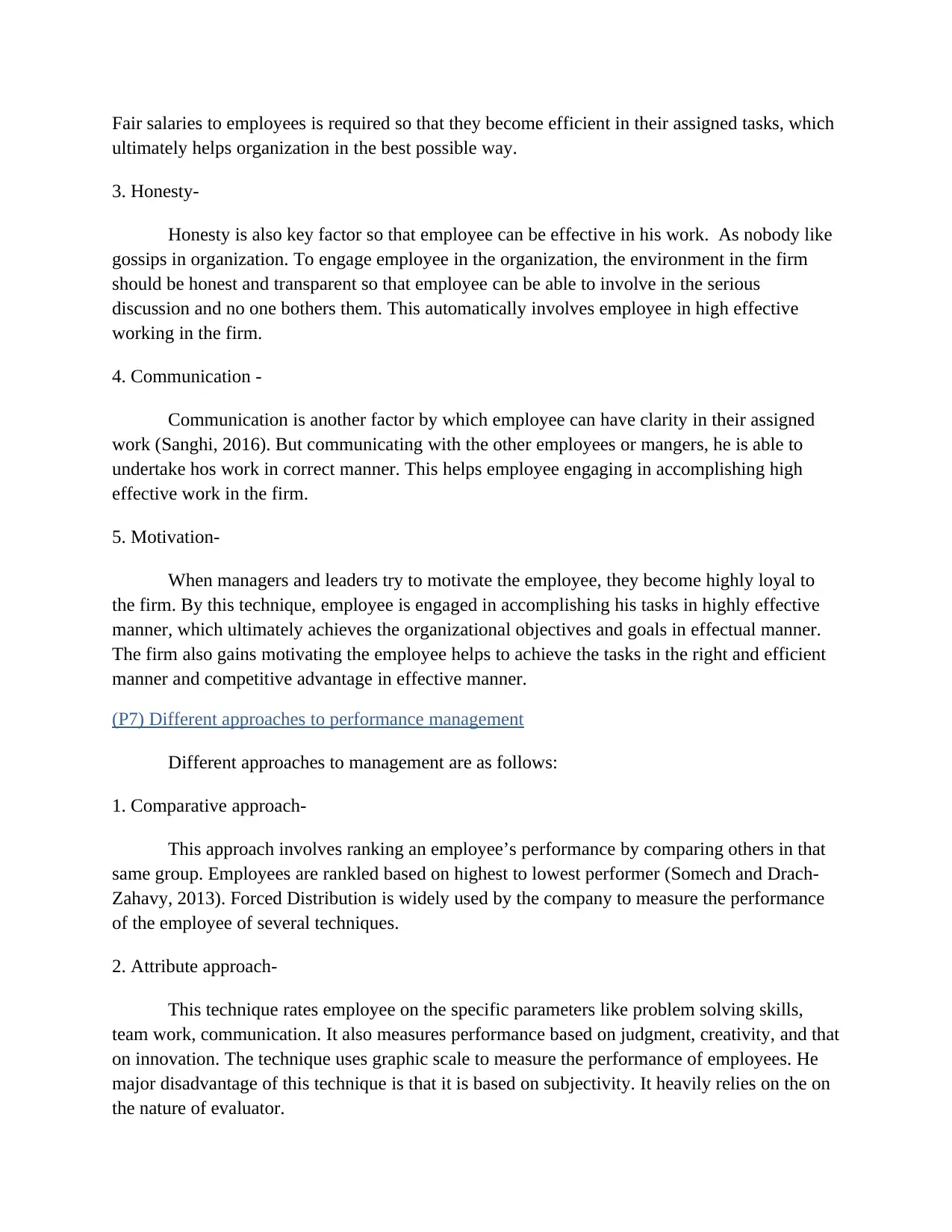
Fair salaries to employees is required so that they become efficient in their assigned tasks, which
ultimately helps organization in the best possible way.
3. Honesty-
Honesty is also key factor so that employee can be effective in his work. As nobody like
gossips in organization. To engage employee in the organization, the environment in the firm
should be honest and transparent so that employee can be able to involve in the serious
discussion and no one bothers them. This automatically involves employee in high effective
working in the firm.
4. Communication -
Communication is another factor by which employee can have clarity in their assigned
work (Sanghi, 2016). But communicating with the other employees or mangers, he is able to
undertake hos work in correct manner. This helps employee engaging in accomplishing high
effective work in the firm.
5. Motivation-
When managers and leaders try to motivate the employee, they become highly loyal to
the firm. By this technique, employee is engaged in accomplishing his tasks in highly effective
manner, which ultimately achieves the organizational objectives and goals in effectual manner.
The firm also gains motivating the employee helps to achieve the tasks in the right and efficient
manner and competitive advantage in effective manner.
(P7) Different approaches to performance management
Different approaches to management are as follows:
1. Comparative approach-
This approach involves ranking an employee’s performance by comparing others in that
same group. Employees are rankled based on highest to lowest performer (Somech and Drach-
Zahavy, 2013). Forced Distribution is widely used by the company to measure the performance
of the employee of several techniques.
2. Attribute approach-
This technique rates employee on the specific parameters like problem solving skills,
team work, communication. It also measures performance based on judgment, creativity, and that
on innovation. The technique uses graphic scale to measure the performance of employees. He
major disadvantage of this technique is that it is based on subjectivity. It heavily relies on the on
the nature of evaluator.
ultimately helps organization in the best possible way.
3. Honesty-
Honesty is also key factor so that employee can be effective in his work. As nobody like
gossips in organization. To engage employee in the organization, the environment in the firm
should be honest and transparent so that employee can be able to involve in the serious
discussion and no one bothers them. This automatically involves employee in high effective
working in the firm.
4. Communication -
Communication is another factor by which employee can have clarity in their assigned
work (Sanghi, 2016). But communicating with the other employees or mangers, he is able to
undertake hos work in correct manner. This helps employee engaging in accomplishing high
effective work in the firm.
5. Motivation-
When managers and leaders try to motivate the employee, they become highly loyal to
the firm. By this technique, employee is engaged in accomplishing his tasks in highly effective
manner, which ultimately achieves the organizational objectives and goals in effectual manner.
The firm also gains motivating the employee helps to achieve the tasks in the right and efficient
manner and competitive advantage in effective manner.
(P7) Different approaches to performance management
Different approaches to management are as follows:
1. Comparative approach-
This approach involves ranking an employee’s performance by comparing others in that
same group. Employees are rankled based on highest to lowest performer (Somech and Drach-
Zahavy, 2013). Forced Distribution is widely used by the company to measure the performance
of the employee of several techniques.
2. Attribute approach-
This technique rates employee on the specific parameters like problem solving skills,
team work, communication. It also measures performance based on judgment, creativity, and that
on innovation. The technique uses graphic scale to measure the performance of employees. He
major disadvantage of this technique is that it is based on subjectivity. It heavily relies on the on
the nature of evaluator.
⊘ This is a preview!⊘
Do you want full access?
Subscribe today to unlock all pages.

Trusted by 1+ million students worldwide
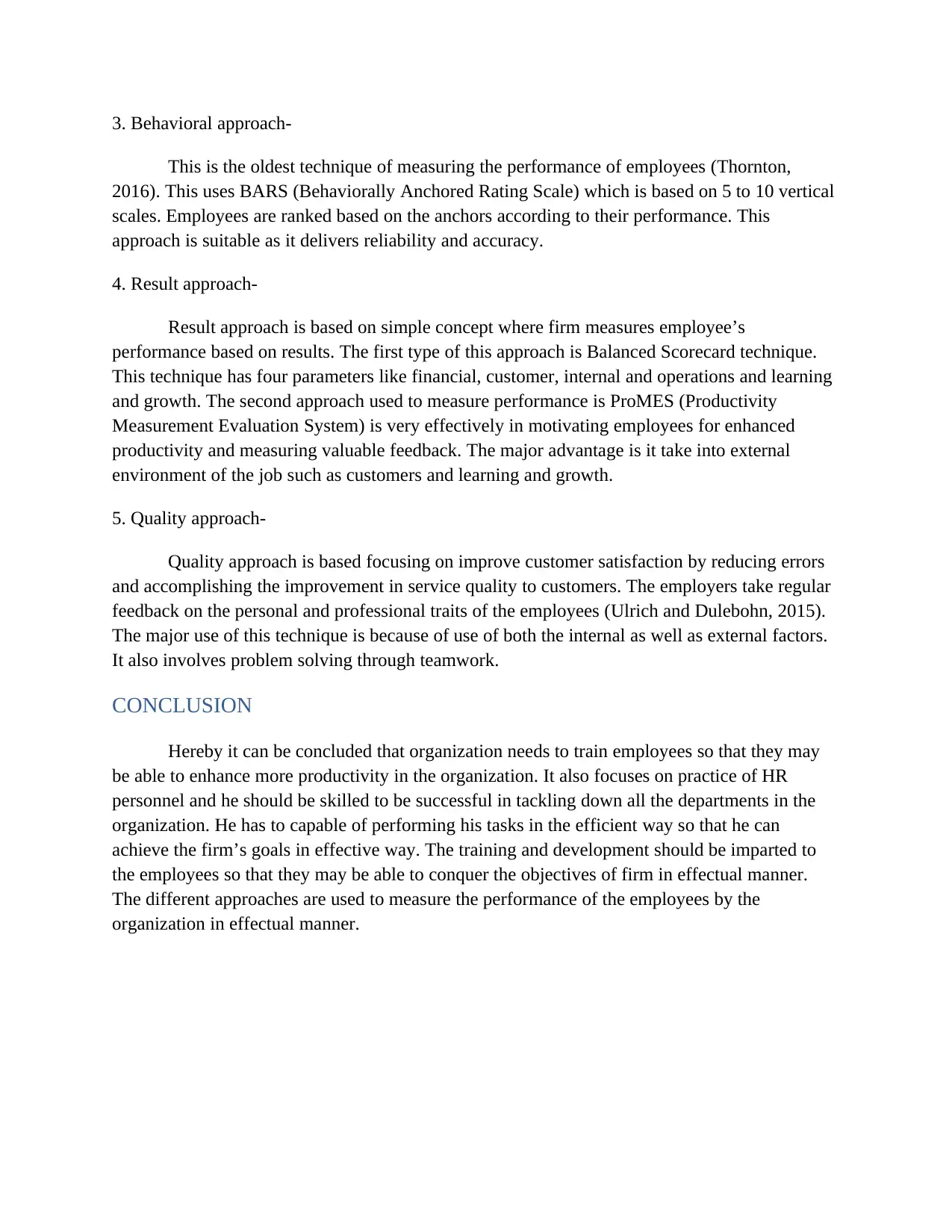
3. Behavioral approach-
This is the oldest technique of measuring the performance of employees (Thornton,
2016). This uses BARS (Behaviorally Anchored Rating Scale) which is based on 5 to 10 vertical
scales. Employees are ranked based on the anchors according to their performance. This
approach is suitable as it delivers reliability and accuracy.
4. Result approach-
Result approach is based on simple concept where firm measures employee’s
performance based on results. The first type of this approach is Balanced Scorecard technique.
This technique has four parameters like financial, customer, internal and operations and learning
and growth. The second approach used to measure performance is ProMES (Productivity
Measurement Evaluation System) is very effectively in motivating employees for enhanced
productivity and measuring valuable feedback. The major advantage is it take into external
environment of the job such as customers and learning and growth.
5. Quality approach-
Quality approach is based focusing on improve customer satisfaction by reducing errors
and accomplishing the improvement in service quality to customers. The employers take regular
feedback on the personal and professional traits of the employees (Ulrich and Dulebohn, 2015).
The major use of this technique is because of use of both the internal as well as external factors.
It also involves problem solving through teamwork.
CONCLUSION
Hereby it can be concluded that organization needs to train employees so that they may
be able to enhance more productivity in the organization. It also focuses on practice of HR
personnel and he should be skilled to be successful in tackling down all the departments in the
organization. He has to capable of performing his tasks in the efficient way so that he can
achieve the firm’s goals in effective way. The training and development should be imparted to
the employees so that they may be able to conquer the objectives of firm in effectual manner.
The different approaches are used to measure the performance of the employees by the
organization in effectual manner.
This is the oldest technique of measuring the performance of employees (Thornton,
2016). This uses BARS (Behaviorally Anchored Rating Scale) which is based on 5 to 10 vertical
scales. Employees are ranked based on the anchors according to their performance. This
approach is suitable as it delivers reliability and accuracy.
4. Result approach-
Result approach is based on simple concept where firm measures employee’s
performance based on results. The first type of this approach is Balanced Scorecard technique.
This technique has four parameters like financial, customer, internal and operations and learning
and growth. The second approach used to measure performance is ProMES (Productivity
Measurement Evaluation System) is very effectively in motivating employees for enhanced
productivity and measuring valuable feedback. The major advantage is it take into external
environment of the job such as customers and learning and growth.
5. Quality approach-
Quality approach is based focusing on improve customer satisfaction by reducing errors
and accomplishing the improvement in service quality to customers. The employers take regular
feedback on the personal and professional traits of the employees (Ulrich and Dulebohn, 2015).
The major use of this technique is because of use of both the internal as well as external factors.
It also involves problem solving through teamwork.
CONCLUSION
Hereby it can be concluded that organization needs to train employees so that they may
be able to enhance more productivity in the organization. It also focuses on practice of HR
personnel and he should be skilled to be successful in tackling down all the departments in the
organization. He has to capable of performing his tasks in the efficient way so that he can
achieve the firm’s goals in effective way. The training and development should be imparted to
the employees so that they may be able to conquer the objectives of firm in effectual manner.
The different approaches are used to measure the performance of the employees by the
organization in effectual manner.
Paraphrase This Document
Need a fresh take? Get an instant paraphrase of this document with our AI Paraphraser
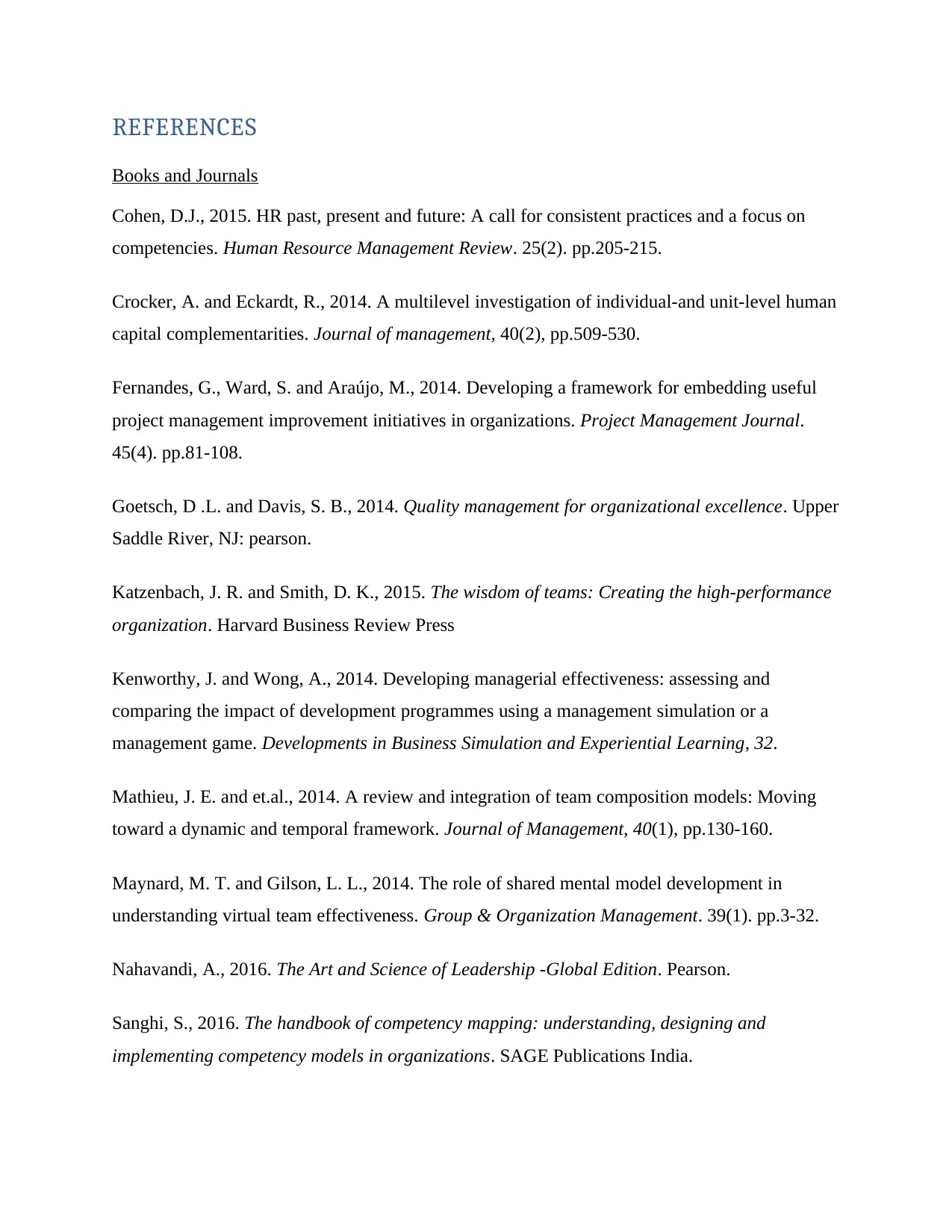
REFERENCES
Books and Journals
Cohen, D.J., 2015. HR past, present and future: A call for consistent practices and a focus on
competencies. Human Resource Management Review. 25(2). pp.205-215.
Crocker, A. and Eckardt, R., 2014. A multilevel investigation of individual-and unit-level human
capital complementarities. Journal of management, 40(2), pp.509-530.
Fernandes, G., Ward, S. and Araújo, M., 2014. Developing a framework for embedding useful
project management improvement initiatives in organizations. Project Management Journal.
45(4). pp.81-108.
Goetsch, D .L. and Davis, S. B., 2014. Quality management for organizational excellence. Upper
Saddle River, NJ: pearson.
Katzenbach, J. R. and Smith, D. K., 2015. The wisdom of teams: Creating the high-performance
organization. Harvard Business Review Press
Kenworthy, J. and Wong, A., 2014. Developing managerial effectiveness: assessing and
comparing the impact of development programmes using a management simulation or a
management game. Developments in Business Simulation and Experiential Learning, 32.
Mathieu, J. E. and et.al., 2014. A review and integration of team composition models: Moving
toward a dynamic and temporal framework. Journal of Management, 40(1), pp.130-160.
Maynard, M. T. and Gilson, L. L., 2014. The role of shared mental model development in
understanding virtual team effectiveness. Group & Organization Management. 39(1). pp.3-32.
Nahavandi, A., 2016. The Art and Science of Leadership -Global Edition. Pearson.
Sanghi, S., 2016. The handbook of competency mapping: understanding, designing and
implementing competency models in organizations. SAGE Publications India.
Books and Journals
Cohen, D.J., 2015. HR past, present and future: A call for consistent practices and a focus on
competencies. Human Resource Management Review. 25(2). pp.205-215.
Crocker, A. and Eckardt, R., 2014. A multilevel investigation of individual-and unit-level human
capital complementarities. Journal of management, 40(2), pp.509-530.
Fernandes, G., Ward, S. and Araújo, M., 2014. Developing a framework for embedding useful
project management improvement initiatives in organizations. Project Management Journal.
45(4). pp.81-108.
Goetsch, D .L. and Davis, S. B., 2014. Quality management for organizational excellence. Upper
Saddle River, NJ: pearson.
Katzenbach, J. R. and Smith, D. K., 2015. The wisdom of teams: Creating the high-performance
organization. Harvard Business Review Press
Kenworthy, J. and Wong, A., 2014. Developing managerial effectiveness: assessing and
comparing the impact of development programmes using a management simulation or a
management game. Developments in Business Simulation and Experiential Learning, 32.
Mathieu, J. E. and et.al., 2014. A review and integration of team composition models: Moving
toward a dynamic and temporal framework. Journal of Management, 40(1), pp.130-160.
Maynard, M. T. and Gilson, L. L., 2014. The role of shared mental model development in
understanding virtual team effectiveness. Group & Organization Management. 39(1). pp.3-32.
Nahavandi, A., 2016. The Art and Science of Leadership -Global Edition. Pearson.
Sanghi, S., 2016. The handbook of competency mapping: understanding, designing and
implementing competency models in organizations. SAGE Publications India.
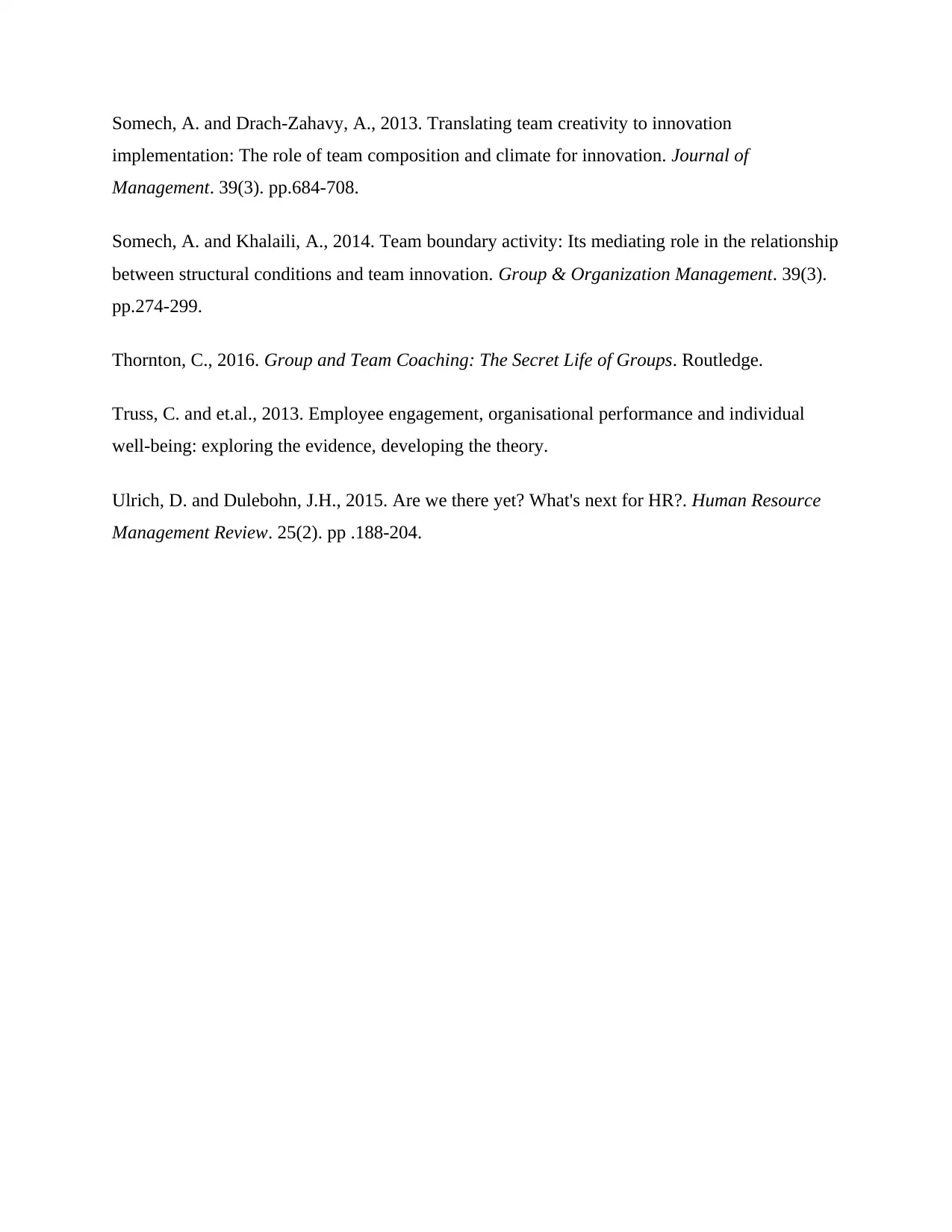
Somech, A. and Drach-Zahavy, A., 2013. Translating team creativity to innovation
implementation: The role of team composition and climate for innovation. Journal of
Management. 39(3). pp.684-708.
Somech, A. and Khalaili, A., 2014. Team boundary activity: Its mediating role in the relationship
between structural conditions and team innovation. Group & Organization Management. 39(3).
pp.274-299.
Thornton, C., 2016. Group and Team Coaching: The Secret Life of Groups. Routledge.
Truss, C. and et.al., 2013. Employee engagement, organisational performance and individual
well-being: exploring the evidence, developing the theory.
Ulrich, D. and Dulebohn, J.H., 2015. Are we there yet? What's next for HR?. Human Resource
Management Review. 25(2). pp .188-204.
implementation: The role of team composition and climate for innovation. Journal of
Management. 39(3). pp.684-708.
Somech, A. and Khalaili, A., 2014. Team boundary activity: Its mediating role in the relationship
between structural conditions and team innovation. Group & Organization Management. 39(3).
pp.274-299.
Thornton, C., 2016. Group and Team Coaching: The Secret Life of Groups. Routledge.
Truss, C. and et.al., 2013. Employee engagement, organisational performance and individual
well-being: exploring the evidence, developing the theory.
Ulrich, D. and Dulebohn, J.H., 2015. Are we there yet? What's next for HR?. Human Resource
Management Review. 25(2). pp .188-204.
⊘ This is a preview!⊘
Do you want full access?
Subscribe today to unlock all pages.

Trusted by 1+ million students worldwide
1 out of 12
Related Documents
Your All-in-One AI-Powered Toolkit for Academic Success.
+13062052269
info@desklib.com
Available 24*7 on WhatsApp / Email
![[object Object]](/_next/static/media/star-bottom.7253800d.svg)
Unlock your academic potential
Copyright © 2020–2025 A2Z Services. All Rights Reserved. Developed and managed by ZUCOL.





